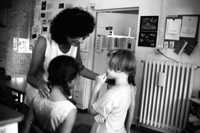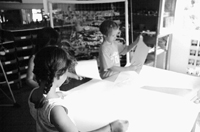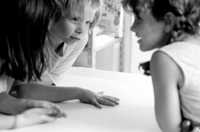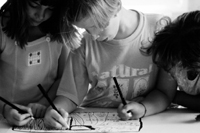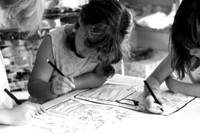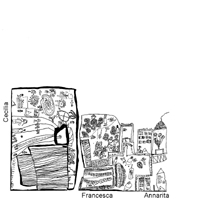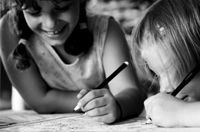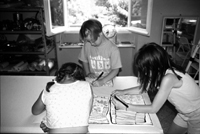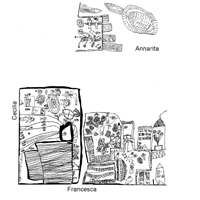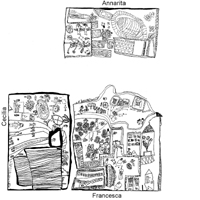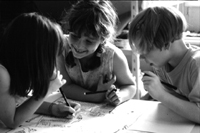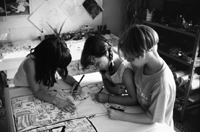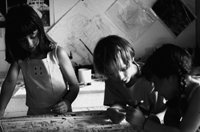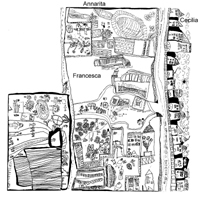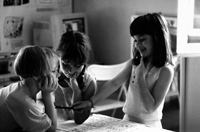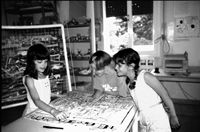In the atelier, three and five year-old girls, Francesca, Annarita, and Cecilia, are sitting with their teacher around a table on which drawing paper of various shapes and sizes and drawing tools have been placed. The girls have agreed with the teacher to make a collective graphic representation of a city. Annarita, Cecilia, and Francesca had already made individual drawings of the city center. Having the girls' previous work on hand will allow the teacher to revisit their thoughts and drawings with them as a premise for starting their work. This will enable each girl to compare her thoughts with those of the others so that they can start exchanging ideas, and will also stimulate their curiosity and foster the creation of a group "microclimate."
Documentation Examples > Examples of documentation that is shared more widely
The City of Reggio
School: Municipality of Reggio Emilia
1. The Girls' City
The girls choose together the type of paper they want to use. The size and shape of the paper itself seem to suggest the position of the town center. Annarita's finger points to and presses down on the middle of the sheet.
The topological identification of the center also determines their starting point, which will not be the town center but their school, which lies outside the center. They decide that they will draw the school as seen from above-a bird's-eye view.
Annarita, Francesca, and Cecilia all sit on the same side of the sheet of paper. It is Francesca, however, who takes the initiative. The use of humor comes into the girls' relational strategies right from the start, immediately creating a group climate in which exchange comes easily.
Francesca: We have to draw it like Simone did, where you can see all the roofs.
Annarita: Yeah, it was really nice, but we have to put the Amusement Park for Birds in it, too, so you can tell it's the Villetta.
Cecilia: And not Milan.
Francesca: Milan! That's silly, are we crazy? We have to do Reggio.
The graphic representation of the school takes a good deal of time. While the girls are drawing, they hold a number of overlapping conversations. Many of these relate to friendships outside the school, and all three girls consistently use the language of prediction to communicate the things they intend to draw. The fact that they started off by drawing a well-mown place such as their school encourages and facilitates the establishment of the tasks that they assign to each person.
The task of representing the city from a bird's-eye view involves an exercise in comparing individual drawing skills, which is resolved quickly through the advice and help of friends. Having defined a topological point of orientation on the map, the girls get into a discussion of the location of each of their houses in relation to the school. Francesca draws the road that leads to the park near her house.
The map of the city follows the girls' criteria of showing the houses. Children's styles, rhythms, and interests are different, and while Annarita and Francesca are exchanging invitations to each other's house, Cecilia continues to draw the school yard in minute detail. At the same time, she keeps in touch with what is happening between her friends, to whom she pays close attention.
The girls' drawing evolves quickly, taking its points of reference from their real-life experiences. The spoken language often precedes the action, as if this action needed to be supported by opinion of the group.
Annarita: If you make the road you're drawing a little bit longer; Francesca, you get to my house. But don't draw it, I'll do it myself later.
Annarita: My daddy works on the other side of town; I'm going over there to do the place were he works.
Cecilia: Yes, go ahead, but make it small, otherwise we can't get the whole city to fit in.
Francesca: Reggio Emilia isn't Milan, you know!
The children's viewpoints of the city are variable and their drawings represent these shifts: views from above, from the side, and in perspective get mixed together in a crescendo of ideas. The girls are also more interested in a city built around the relationships it offers than in its function of spatial connection. To them, the relational function predominates: parks, streets, and squares are places of events and actions filled with real-life experiences, which are expressed in both their drawing and their spoken language.
Francesca is particularly interested in the parks, and she begins to draw one that is in the town center.
Francesca: It's the park where everybody goes to have fun. There are lots of people in the park in the afternoons. There are lots of parks in cities, where people can play and relax; if there weren't any, people wouldn't know where to go and relax.
Streets become connecting links between related places, and it seems that there are two important ones: the Via Emilia, the main crosstown street that runs close to the school, and Via Citta di Reggio, where Cecilia lives. It's Cecilia herself who makes a connecting link between what Francesca and Annarita are doing, by joining the two parts of the city, thus building a spatial boundary that allows a better estimation of what has to be done later.
Cecilia begins to draw her house and the other ones on her street. It seems that the idea of the continuing city is very strong for this group of girls, where spaces are interwoven and run up against each other, and where streets are symbolic borders between microworlds. After working individually, the girls change places again, and they are now coming together around a single objective: the city center and its buildings.
Cecilia: Cities never end. They're all joined together like houses. I live on Via Citta di Reggio and my house is joined to another one-it's a duplex.
An animated discussion begins about familiar places that are going to be represented. The girls agree that the mayor's house should be the first one to be drawn, followed by the theater and the cathedral with the tower in the main square.
The girls often stop to look at their work and assess it together, expressing a strong aesthetic pleasure in what they've done.
Once again the Via Emilia and the squares become the focal points of the city, as well as of the discussions they have about what to do.
Francesca: There aren't just one or two squares in the city, there are lots of them-not two, like we did!
Annarita: I think there are a lot; there are a few on this side of the Via Emilia and a few on that side.
In the end, they decide that each of them will draw one square, dividing the remaining territory into four sections.
At the end of their drawing, the three girls comment on their work.
Francesca: See, when you walk in the town, you can see how the city is made. If you go up high on the top of a house, you can see the city all around and you can see the squares from up high.
Cecilia: Where the square stops, there's a sidewalk with all the houses attached.
Annarita: In the squares there's a lot of confusion, everybody's talking.
The city represented by Cecilia, Francesca, and Annarita is a city full of relationships and life. The parks, the squares, the houses, and the Villetta School, for example, are not only elements of a topological point of view, but they are also, important elements for building relationships between the life of the people and their city.

